Northern to Southern Utah
Levi and Eunice Chidester Harmon
Orin and Ann Cannon Woodbury
John and Margaret Webster Esplin
Israel and Clarissa Miller Hoyt
With all
the ancestors of Frank Harmon and Lillie Esplin in northern Utah, when and why
did they move south? The answer is the same for all four families. They were
called by Brigham Young to colonize the southern part of the Utah territory.
| Frank Harmon's grandparents, Levi Nehemiah and
Eunice Chidester Harmon began their married life in Palmyra as shown in the
Bishops' Report at the right. |
 |
 |
The city is south of Utah Lake and west of
Spanish Fork. Many saints had gone to Palmyra because Brigham Young had advised
them to leave the Salt Lake City area before the arrival of Johnson's Army.
(The army that was sent to Utah territory to stop polygamy) |
| Levi and Eunice's first two children were born in
Palmyra - Eunice in 1855 and Levi N. in 1857. |
 |
| By 1860 they had moved to Salt Lake City in the
Second Ward. |
 |
The family is listed in the 1860 census with
three children- Eunice(Unice), Levi N., and Oliver. Melvin Myron was born a
year later in 1861 and Elmer in 1864.

| The move to Dixie came in 1865. Brigham Young
asked for volunteers and the families of Levi N. Harmon and his father-in-law,
John M. Chidester, agreed to go. To the right is a map showing the move from
Salt Lake City to Washington. |
 |
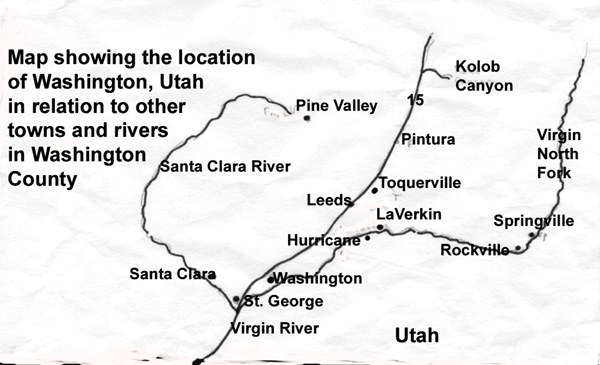
|
They settled in a valley adjacent to St. George
which they named Washington. |
After they came to Washington, Elmer,
died at 2 years of age in 1866 and two children were added to the family -
Esther (1867) and Willard Darwin (1870) as shown below in the Washington Ward
Record of Members showing all but their oldest child, Eunice.

The family struggled to tame the Virgin River and
provide water for their farms. Swamps near Washington bred the mosquito causing
malaria. Below is an excerpt telling of Melvin's efforts to get medicine for
the family.

As always in farming they had good and bad
years.

Levi N. Harmon helped his
second cousin Appleton Harmon build a cotton mill. Eunice was one of the first
to work there.

"Levi & Eunice Chidester
Harmon" by Enid Harmon Johnson
| To the right is a painting by Jodi McGregor
celebrating the Dixie cotton industry.. |
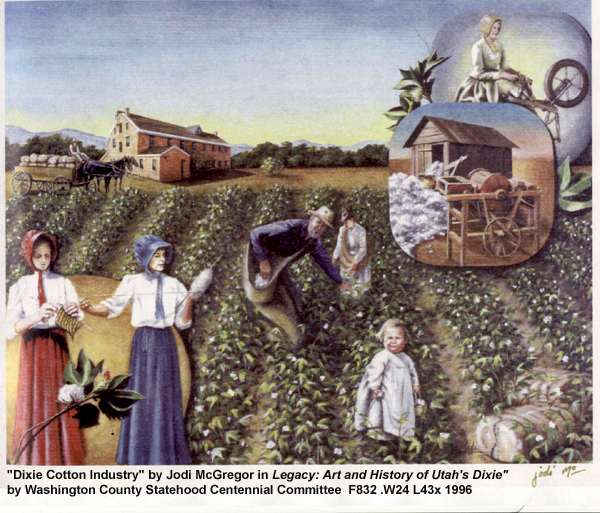 |
Below are two photos of the mill - the one on
the left was taken in 1870 when the mill was at the peak of production. The one
on the right was taken in 1928.
 |
W |
The family
moved to Clover Valley near Pioche, Nevada for a brief time. Three of Levi's
sons worked as teamsters hauling lumber from Pioche to Clover Valley.
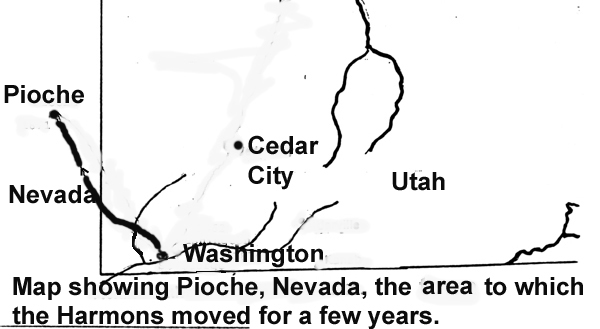
Below are pictures of the whole family (at various ages) except Elmer
who died in infancy
.
Below is a family group sheet showing birth
dates of family members.

When the family returned to Washington in 1874,
Levi died very suddenly at age 45.
Eunice became head of the family as
shown in the 1880 census .
"Eunice Harmon"
by Lora Thompson
|
 |
 |
In 1876 the oldest daughter Eunice married Simeon
Dunn and Oliver married Almira Terry in 1881. He and Almira are shown in the
picture at left. |
| Eunice Harmon was left to raise the four younger
children alone. At right she is shown with the two youngest - Esther Ella and
Willard Darwin (who died in 1882 at age 12) |
 |
 |
Frank's father Melvin and his brother Levi hauled
lumber in order to support the family. On one trip up the Sevier River with a
load of grapes they discovered that everyone wanted grape juice. So the
enterprising brothers made the grapes into juice. (Don't ask me how; maybe they
stomped on it with their bare feet). They traded the juice for grain, flour and
pork.
Excerpt from
"Melvin Myron Harmon" by Alice Harmon Ballard page 2 |
| The grapes were grown in Washington-a warm place
which grapes like to grow in. |
 |
Melvin went to school part time at the
District School until he was 21. To the left below is a drawing of a St. George
Ward schoolhouse which may have looked similar to the first schoolhouse built
in Washington. That Washington school is described below on the right.
| Eunice moved the the family to Provo so that she
could send her children to the Brigham Young Academy. She served as a midwife
and did all kinds of work to keep her children in school. To the right is an
old postcard picture of Karl G. Maeser the second administrator of the school.
|
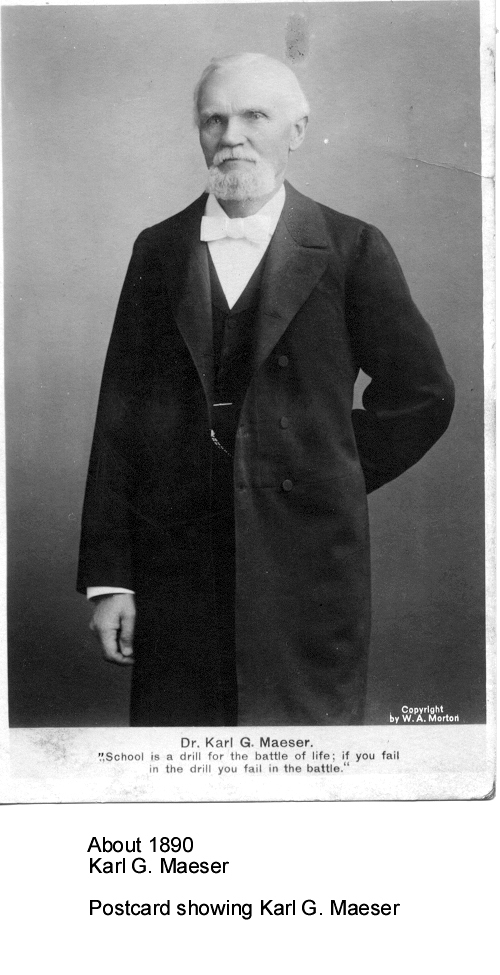 |
 |
To the left is the restored academy building
standing on the location of the first building(the Lewis Building) which was
destroyed by fire. |
| After attending BYU Academy Melvin Harmon became
a teacher and taught in St.George, Santa Clara, Toquerville, Kanarraville,
Cedar City, and Leeds. |
 |
Melvin was
considered an excellent teacher. Kanarraville had a reputation for driving
teachers out so the school board sent Melvin to teach there. He reported
initial difficulties but he lasted the year.
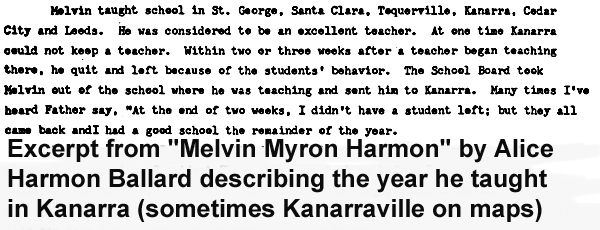
Back to Top
Now back to Frank Harmon's mother's side of the
family to see when the Orin and Ann Cannon Woodbury family arrived in southern
Utah.
| Orin and Ann C. Woodbury first lived in Salt Lake
City. Two children -Eleanor and Orin Nelson, junior were born there. In 1857
Orin answered the call to stop Johnson's Army. He traveled with Lot Smith in
what sounded like guerilla warfare. The group was in several skirmishes in Echo
Canyon. Orin survived the battles but did not fare well on a diet of dough
fried in grease. (He evidently didn't learn the survival trick of cooking dough
in hot ashes). |
 |
| Orin and Ann moved back to Salt Lake City and
lived in several places - near Taylorsville, on Little Cottonwood Road and in
South Salt Lake. Two more children were born to them - Annie Marie (1858) and
George Jeremiah (1860). |
 |
| They left that fall (of 1861) and took four weeks
to get to what is now St.George. They camped at the "Old Adobe Yard" on the 3rd
of December 1861. Their welcome to the desert area of southern Utah was 40 days
of rain making the adobe yard a very uncomfortable campground. To the right is
a picture of the family in about 1865. |
 |
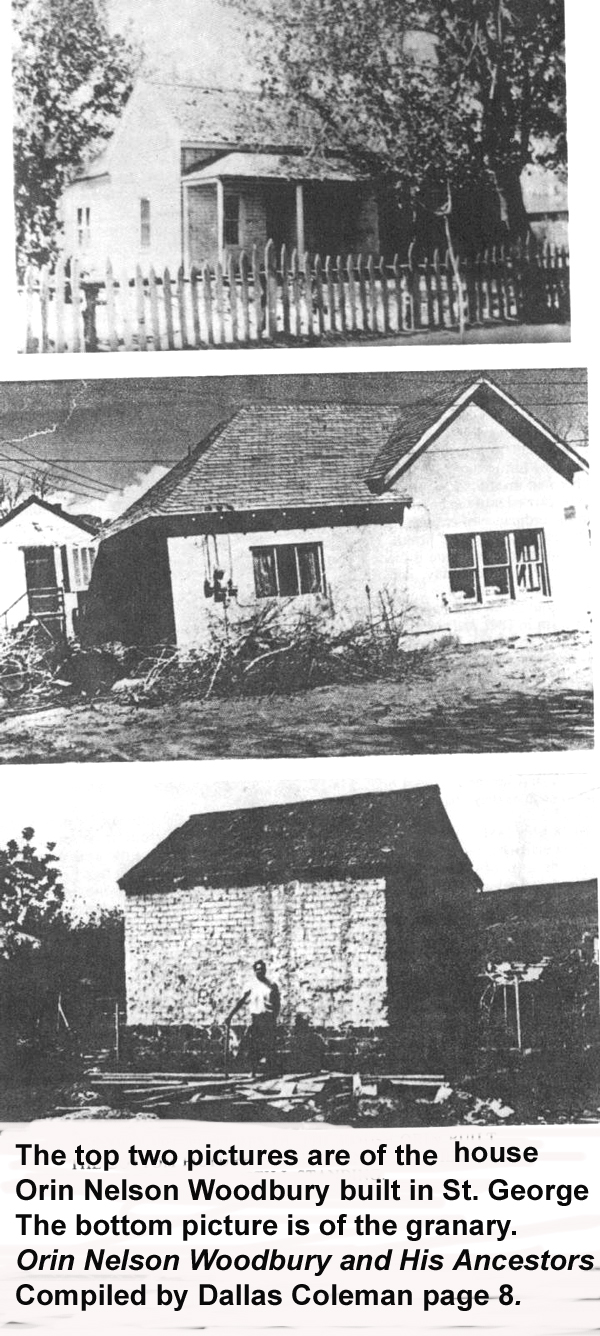 |
Orin soon built a four room adobe house for his
family. To the left is a house built by Orin N. Woodbury in St. George but it
doesn't look like a four room adobe house. It was probably built later. |
 |
Ann Woodbury was a pioneer in the silk industry
starting to raise worms in 1877 and involved in the industry for 25 years. Her
low opinion of one of the weavers makes interesting reading.
"Reminiscences of Ann Cannon
Woodbury" edited by Angus M. Woodbury p 14
To the left is a picture of
a silk dress made in St.George .(worn by her daughter, Alice Woodbury Harmon,
Frank Harmon's mother) |
| In 1866 Orin married a second wife, Frances
Goddard. At right is her picture. |
 |
 |
With two families to care for, Orin spent less
time with Ann. She went on trips accompanied by her children. She was busy
being stake Relief Society president (for 21 years), counselor in the stake
Primary and worker in the temple. |
And in having
accidents. Below, in her own words she describes cutting her hand, falling down
steps, tripping on a blanket etc etc etc.

| Six more children were born to Ann in St. George
- John T.(1863), Leonora (1865), Frank B. (1867), Alice (1870-Frank Harmon's
mother), Angus (1873), and Clara (1875). |
 |
 |
The town of St. George grew and prospered. In
1876 the tabernacle was completed as shown in the picture at the left. |
| In 1877 the St. George Temple was finished - the
first one in Utah. |
 |
Ann Woodbury carried on her active life
of travel, church work, raising silkworms, keeping bees (and having accidents)
for 31 years after her husbands death. Below are pictures of Ann.
| Ann's children, of course were growing up. Her
daughter Alice had grown into a young lady by 1890 shown in the picture at
right. She learned to sew and was so skillful that at 17 she went to Salt Lake
to take courses in dress making. |
 |
 |
The picture at the left shows her with friends at
about age 20. |
| Alice caught the eye of Melvin M. Harmon ( Frank
Harmon's father). They first met in July 1880 at a Mutual-Sunday School
Conference in Pine Valley a resort are north of St. George. To the right is a
picture of Melvin with the Sunday School Board. . |
 |
 |
To the left is a picture of the church in Pine
Valley where the Mutual-Sunday School Conference was probably held. |
People noticed the attention Melvin paid
to Alice. One friend remarked, "That's a sure match." Alice said that after
that meeting he told two friends that he was going to get away with Alice
Woodbury.
Below is an excerpt from Alice's Journal describing the romance
in her own words.

| Alice was teaching at Grafton; Melvin was
teaching at Leeds. He would go to see her every two weeks in a horse-drawn cart
or on horseback. The map at the right shows the distance between the two towns.
|
 |
Melvin later told her that when he used
the horse he had to come from the upper street so Alice couldn't see that his
saddle had only one stirrup Below is a painting of Grafton (which is now a
ghost town) by Gaell Lindstrom.

Alice evidently clinched the
romance with a kiss. She said, "On New Year's Eve we were at a party at John
Sullivan's and were playing ‘Spat Out', (We need to find the rules for
this game) and when he sat down, I kissed him. He said afterward that it went
through him like an electric shock and he knew from then on that he was on the
right track
Back to
Top
How did Lillie Esplin's grandparents get
to southern Utah? Her grandfather John Esplin had married Margaret Webster, the
girl from England; they immediately moved to Salt Creek now known as Nephi.
 |
Brigham Young had called them to add support to
the saints in Salt Creek who were having problems with Indians. To the left is
a map showing their move from Salt Lake City to Salt Creek. |
| In 1854 Brigham Young instructed them to build a
fort. To the right is a map showing where the John Esplin family lived in the
fort - named Fort Nephi. John and Margaret Esplin lived there from 1853 - 1868
(Maybe that is why the name of the town was later changed to Nephi.) |
 |
John was called to be a guard during the Johnson Army
crisis in 1857. He was also gone for 7 months driving a team to Florence
(probably in Kansas) to help those emigrating westward.
| Lillie's father, John James was born in Nephi in
1857. According to the History of Juab County shown at right, John
Esplin received his final citizenship in Nephi. |
 |
 |
On the 20th of September 1868, Margaret and John
Esplin's eighth child, David was born and they received a call to go to the
Muddy Mission.
Were
the Virgin and Muddy River Names Switched?
At left is a map showing
the distance from Nephi to St. Joseph - one of the towns in the Muddy Mission.
|
John took his oldest son John James and
went to the settlement at St. Joseph to prepare a home for the family. The rest
of the family came the next year, and Margaret had her ninth child, Clara
Isabel in St. Joseph - born the 31st of October 1870. The record of her birth
is shown below in the Orderville Record of Members.

The "Muddy" is a desert - a wide open area that
seems to stretch out in all directions. To the right and below are recent
photos of the area taken of the remains of St. Thomas (another town in the
Muddy Mission) that have surfaced because of receding waters of Lake Mead.
Daily Herald Article About
St. Joseph 31 August 2003 |
 |
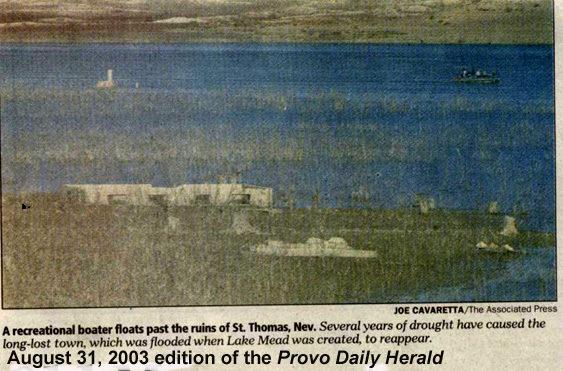
 |
To the left is a map showing the location of St.
Joseph , one of the towns in the Muddy Mission. |
| In 1870 the section of land comprising the Muddy
Mission was made part of Nevada. The government of Nevada insisted they pay
three years back taxes. They could not do that because they had already paid
Utah taxes. Brigham Young released them and said they could go where they chose
but recommended two settlements in Berry Valley (now called Long Valley) that
had been abandoned because of Indian problems. |
 |
The valley had
been named after the Berry brothers who were the first settlers. They had been
killed in the trouble with the Indians. The settlement on the south end of the
valley was called Windsor. The History of Kane County by the Kane County
DUP explains why its name was changed to Mt. Carmel.

The other town on the north end of
the valley was Berryville now called Glendale. The reason for that change is
explained in the History of Kane County by the Kane County DUP as seen
below.

Two groups from the Muddy Mission sent a
surveying party to Long Valley and they returned with a good report. So the
saints in Saint Joseph decided to travel as a ward to the town on the south -
the one that became Mt. Carmel.
| Margaret Esplin really wanted to return to Nephi.
She talked about it so much that when they came to the turn-off point for Nephi
at Toquerville, John told his wife she could take one of the teams and go to
Nephi. |
 |
As seen in the excerpt below, Margaret
did not want to go to Nephi without John. She chose to accompany him to Long
Valley.

Her decision didn't make the journey easy. It
was winter (February) and the men had to stop and make a trail through the
snow. They followed the Virgin River to St.George
Argument about the Route from St.
Joseph to St.George
I have now decided that my assumption that the
route from St. Joseph to St. George followed the Virgin river through the
narrows is wrong. After reading Not of This World by Lucy Parr written
in 1975 by an author who grew up in Orderville and knew many of the early
pioneers, her account says the route from the Muddy Mission left the Virgin
River before the narrows and went up Castle Cliff Wash and then over to St.
George. A dry wash would certainly be easier to travel than a narrow canyon
with a river in it.
From St.George they traveled 80 miles over the Arizona
strip through Colorado City (Short Creek) to Moccasin, and north through the
sand dunes to Long Valley.

| Margaret had two month old Clara Isabel in her
arms and two year old Dave dragging on her hand. She said, "I felt I just
couldn't go on." Her dramatic solution to the problem surprised even quiet John
Esplin. |
 |
 |
They left St. Joseph in February 1871 and arrived
in Windsor(Mt. Carmel) the 4th of March 1871. After they arrived and had set up
homes, the saints who had deserted the town returned to claim their
property. |
The disagreements between the Muddy
settlers and original settlers continued. In March 1874 the saints from the
Muddy Mission wanted to obey church counsel to live with all things in common.
Some families in Mt. Carmel did not want to live what they called the united
order. Those who did were advised by church leaders to move 3 miles north to
make a new settlement as described in the excerpt below.

| So early in 1875 those who wanted to live the
"order" moved and built their homes in a square like the Old Fort in Salt Lake
City. On July 14, 1875 they officially reorganized themselves and named the
settlement "Order City." Later it became known as Orderville. |
 |
 |
Lillie Esplin's grandfather, John Esplin was a
member of the first board of directors. To the left is a picture of John and
Margaret with children and/or grandchildren.
|
The
homes faced inward. The dining hall was in the center. It measured 25' by 40'
and was large enough to seat everyone. It was also used for church and social
gatherings. On the north side of the dining hall was a kitchen with a brick
oven in back. Below is the painting with numbers for the buildings.

 |
People were summoned to meals by a bugler. The
wake-up tune was "O Ye Mountains High." |
| The call to breakfast was "Do What is Right."
(Was that a hint to avoid pigging out on breakfast?) |
 |
| John James Esplin was fourteen when they arrived
in Mt. Carmel. By the time the "order" moved to establish Orderville, he was
18. His chances for a formal education were limited but adult education was
part of Orderville life and classes were open to all. |
 |
As seen in the excerpt below and the
picture, John James was a good-looking young man.

| John James grew up in a large family. His two
youngest sisters were born after he left home to get married. To the right is
the John Esplin- Margaret Webster family group sheet. |
 |
Back to Top
When did Lillie
Esplin's mother Emily Alvira Hoyt with her parents (shown below) - Israel and
Amanda Miller Hoyt, arrive in Orderville? Israel Hoyt and Clarissa Manda Miller
had married a year after their families arrived in Utah in 1847.
History of Clarissa
Amanda Miller Hoyt
Patriarchal blessing for Clarissa
Amanda Miller Hoyt
Second patriarchal blessing for
Clarissa Amanda Miller Hoyt
| In 1851 Israel and Amanda moved to Salt Creek
(Nephi) as shown in the map at the right.("History of Israel Hoyt" by Harriet
B. Sorenson. |
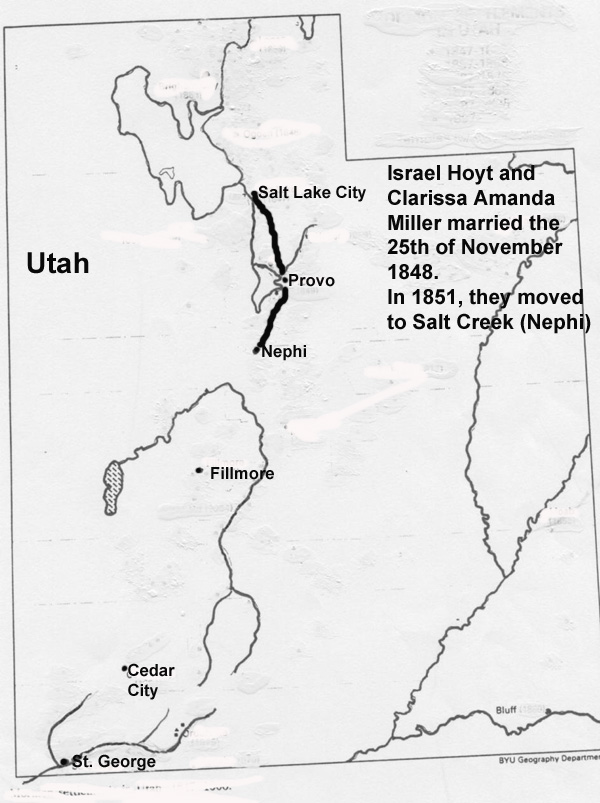 |
 |
They lived in the fort (built in 1854) and their
names are on the map at the left. Israel's parents, James and Beulah Sabin Hoyt
died in Nephi and were buried in the Pioneer Cemeter. |
The 1852 Bishops' Reports below show
Josiah Miller, his son, Miles and his son-in-law Israel Hoyt all living in
Nephi.


 |
The History of Juab County lists Israel Hoyt as
the sheriff as shown at left. |
| Clarissa Amanda Miller Hoyt's father, Josiah
Miller was the first mayor of Salt Creek(Nephi) |
 |
 |
In 1856 Israel Hoyt married a second wife, Hannah
Cook, shown with Clarissa Hoyt in the picture on the left. |
| To the right is a picture of Israel Hoyt with son
Timothy (born to his second wife, Hannah). |
 |
While the Hoyts were living in Nephi,
Emily Alvira (Lillie Esplin's mother) was born on the 8th of December 1858 as
shown in the excerpt below.
"History of Israel
Hoyt" by Harriet Sorenson p.2
In 1865 seven year old Emily Alvira
would have known eight year old John James Esplin.

Patriarchal
blessing for Emily Alvira Hoyt
| In 1868 the Israel Hoyt family was called to the
Muddy Mission. They arrived in St. Joseph a few days before Christmas 1868. To
the right is a map showing the distance between Nephi and St. Joseph. |
 |
 |
The Hoyts were in St. Joseph with the Esplins
when the land was surveyed and found to be in Nevada. They left with the
St.Joseph Ward when Brigham Young released them and traveled to Berry Valley -
now Long Valley. |
The Hoyts joined the United Order and
moved north in 1874 to the new settlement that became known as Orderville.
Israel Hoyt was the president of the Board of Directors as shown below.

 |
He was also the overseer of the sawmill as shown
on the left. |
Israel Hoyt married a third wife, Bertha
Fackrell on the 25th of April 1880. In 1883 their daughter became deathly ill
with the measles and Israel was rushing home when his horse fell with him and
he died of injuries sustained in the fall. Below is a picture of the Israel
Hoyt family. It was probably taken at the time of his funeral in 1883.
"History of
Israel Hoyt by Harriet Sorenson pp 1-4

In the second year of the Order John
James Esplin married Harriet Leonora Allen and Emily Alvira Hoyt on the 10th of
July 1876. Below are excerpts from the index to temple records showing that
John James Esplin's record was on page 401, Emily Alvira's record was on page
402, Harriet Leonora Allen's record was also on page 402. (The marriage
ceremony is on film #183,401).
An excerpt from the 1880 census below
shows the John James Esplin family with his two wives and three children. Above
John James is the record of Israel's father-in-law's family. (Bertha does not
show on the census which must have been taken before her marriage to Israel in
April 1880).

One of John James Esplin's granddaughters (Verna Holgate Pugh) told Lillian
Harmon Heil and Shirley Esplin Hart that John James would not have married two
wives if Israel Hoyt had not refused to let him court his daughter(Emily
Alvira) unless he entered into polygamy. If that is true, John James was in a
situation similar to Jacob who wanted to marry Rachel but had to marry Leah in
order to get to marry Rachel. Below is a picture of the visit with Verna Pugh
in 2002.

Because John Esplin and Margaret Webster
Esplin lived longer than their Hoyt grandparents, the grandchildren had many
memories of their Esplin grandparents.
Margaret Esplin was remembered fondly because she
always fed them and because she loved to sing church hymns - happy or sad she
sang them - but not in tune because she was hard of hearing. One granddaughter
said she sang with so much feeling that it didn't matter if the tune was
incorrect.
"History of Margaret
Webster Esplin" by Hattie Esplin |
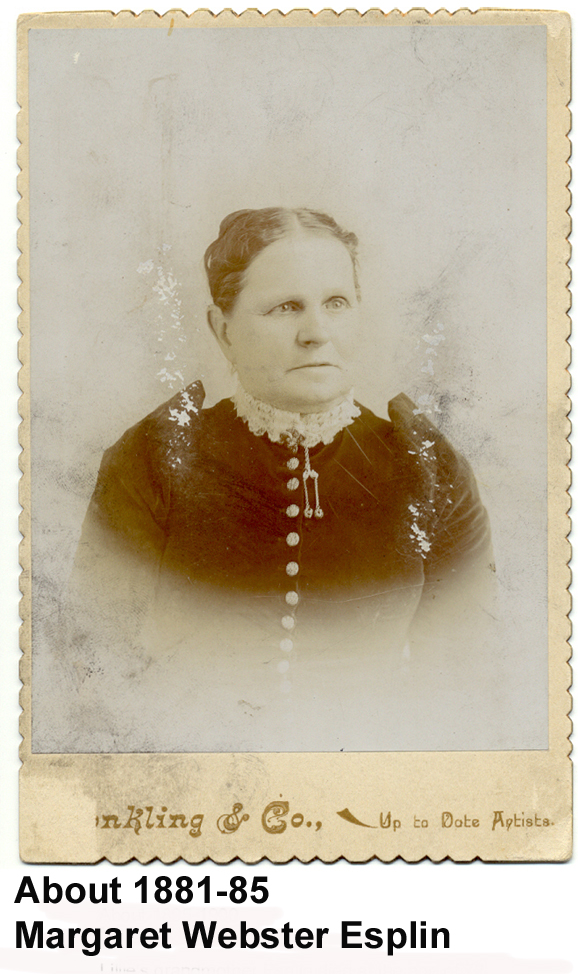 |
Memories of
John Esplin often focused on his sayings. Below is one of his favorites.
| His Scotch background was a subject of amusement
in the community, but he insisted that Scots aren't stingy; they are just
careful with their resources as indicated by another of his favorite sayings on
the right |
 |
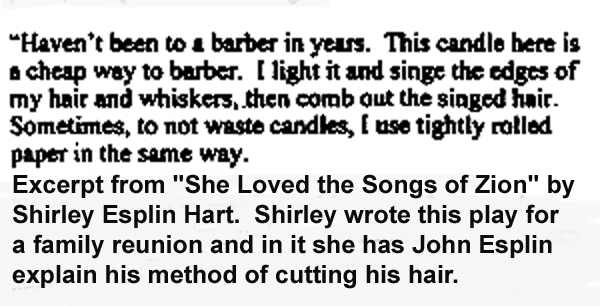 |
He proved how careful he was of his resources
with his hair cutting method. As shown at left he never went to a barber. He
singed the edges of his hair and beard with a candle and then combed out the
singed ends. |
Lillie Esplin never knew her grandfather
Hoyt ( who died in 1883) or her grandfather Esplin (who died in 1895). She was
one of the youngest in John James Esplin's family born in 1898. |
|
|